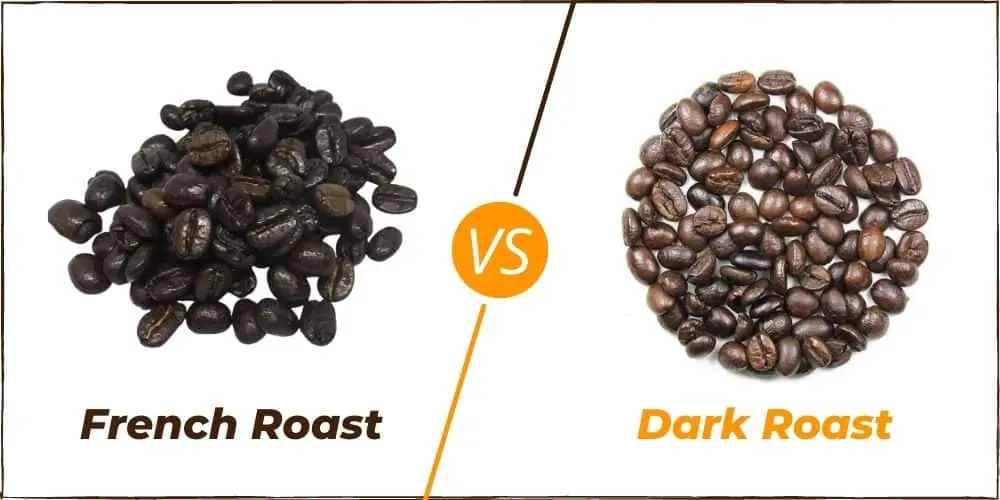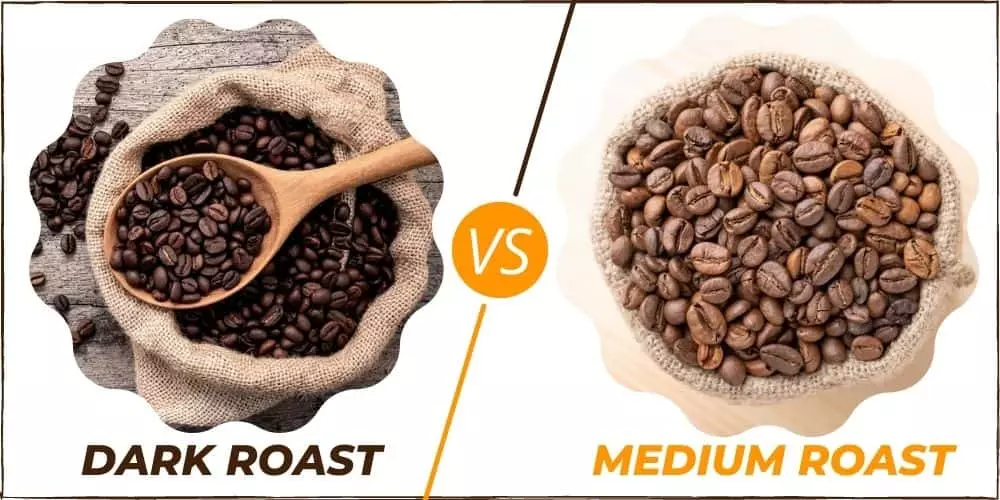If you’re a coffee lover, you know that the flavor, aroma, and characteristics of your brew can vary greatly depending on the type of coffee beans you use. One crucial factor that affects the taste of your coffee is the roast level of the beans. Among the various roast levels, light roast and dark roast are two popular options that come with distinct flavor profiles and brewing methods.
In this comprehensive guide, we’ll explore the differences between light roast and dark roast coffee beans, diving into their characteristics, flavor profiles, brewing methods, and pros and cons. Whether you’re a seasoned coffee enthusiast or a curious beginner, this article will provide you with valuable insights to help you make an informed decision about which type of roast is right for you.
Let’s dive into the world of coffee roasting and discover the nuances of light roast and dark roast coffee beans!
Understanding Light Roast Coffee Beans
Light roast coffee beans are known for their delicate and nuanced flavors. They are roasted at a lower temperature and for a shorter duration compared to other roast levels, resulting in a lighter color and a denser texture. Light roast beans retain more of their natural flavors and have higher acidity compared to darker roasts.

One of the key characteristics of light roast coffee beans is their distinct flavor profile. Light roast coffees tend to have bright and vibrant flavors with pronounced acidity, floral and fruity notes, and a lighter body. The acidity in light roast beans can range from citrusy to wine-like, adding a refreshing and tangy taste to the brew. The lighter body of light roast coffee allows the natural flavors of the beans to shine through, resulting in a clean and crisp cup of coffee.
When it comes to brewing methods, light roast beans are well-suited for pour-over, Aeropress, Chemex, and other manual brewing methods. These methods allow for precise control over brewing parameters, such as water temperature and brewing time, which can enhance the unique flavors of light roast coffee beans. The recommended grind size for light roast beans is usually medium-fine to fine, allowing for proper extraction of flavors without over-extraction.
Despite their many strengths, light roast coffee beans may not be everyone’s cup of coffee. Some coffee drinkers find the acidity of light roast beans too sharp, while others prefer a bolder and darker taste. Additionally, light roast beans may have lower caffeine content compared to darker roasts, as the longer roasting process of darker roasts can lead to higher caffeine extraction. However, for those who appreciate the bright and complex flavors of light roast coffees, they can be a true delight for the taste buds.
Understanding Dark Roast Coffee Beans
Dark roast coffee beans are known for their bold and robust flavors. They are roasted at a higher temperature and for a longer duration compared to other roast levels, resulting in a darker color and a more oily surface. Dark roast beans have a less dense texture and a shiny appearance due to the oils that are brought to the surface during the roasting process.

One of the main characteristics of dark roast coffee beans is their distinct flavor profile. Dark roast coffees are known for their rich and intense flavors with low acidity, dark chocolate, caramel, and smoky notes, and a fuller body. The longer roasting process of dark roast beans leads to the caramelization of sugars and oils, resulting in a sweeter and bolder taste. The lower acidity in dark roast beans makes for a smoother and less tangy cup of coffee, which is often preferred by those who enjoy a more robust flavor profile.
Dark roast beans are versatile and can be brewed using a variety of methods, including drip brewing, French press, espresso, and cold brew. The recommended grind size for dark roast beans is usually medium-coarse to coarse, allowing for proper extraction without over-extraction, which can result in a bitter taste.
Dark roast coffee beans are favored by many for their strong and bold flavors, making them a popular choice for those who prefer a more intense coffee experience. The longer roasting process of dark roast beans also leads to a darker appearance, which some coffee drinkers find visually appealing. Additionally, dark roast beans often have a lower caffeine content compared to lighter roasts, as the prolonged roasting process can result in some caffeine loss.
Flavor Profiles of Light Roast vs Dark Roast Coffee Beans
The flavor profiles of light roast and dark roast coffee beans are distinct and offer different taste experiences for coffee lovers.
Light Roast Coffee Beans
Light roast coffee beans are known for their bright and vibrant flavors. They often exhibit a higher level of acidity, which can range from citrusy to wine-like, adding a tangy and refreshing taste to the brew. Light roast beans also showcase floral and fruity notes, with hints of berries, citrus, and tropical fruits. The lighter body of light roast coffee allows the natural flavors of the beans to shine through, resulting in a clean and crisp cup of coffee.
The delicate flavors of light roast coffee beans are well-suited for those who enjoy a more nuanced and complex taste profile. The higher acidity and brighter flavors can be particularly appealing to those who appreciate a zesty and tangy cup of coffee. Light roast beans are often preferred by specialty coffee enthusiasts who enjoy exploring different flavor profiles and tasting the unique characteristics of different coffee origins.
Dark Roast Coffee Beans
Dark roast coffee beans, on the other hand, are known for their bold and robust flavors. The longer roasting process of dark roast beans leads to the caramelization of sugars and oils, resulting in a sweeter and bolder taste. Dark roast coffees are characterized by dark chocolate, caramel, and smoky notes, with a fuller body and a lower level of acidity compared to light roasts.
The rich and intense flavors of dark roast coffee beans are often favored by those who enjoy a more robust and full-bodied cup of coffee. The lower acidity and darker flavors can be appealing to those who prefer a smoother and less tangy taste profile. Dark roast beans are often used in espresso-based drinks, such as lattes and cappuccinos, as their bold flavors can stand up well to the addition of milk and other flavorings.
Comparing Flavor Profiles
When comparing the flavor profiles of light roast and dark roast coffee beans, it’s important to note that it ultimately comes down to personal preference. Some coffee drinkers may prefer the bright and complex flavors of light roast beans, while others may enjoy the bold and rich flavors of dark roast beans.
Light roast coffee beans are ideal for those who enjoy a brighter and more nuanced taste profile, with higher acidity and floral/fruity notes. They are well-suited for manual brewing methods that allow for precise control over brewing parameters, resulting in a crisp and vibrant cup of coffee.
Dark roast coffee beans, on the other hand, are ideal for those who prefer a more robust and intense flavor profile, with lower acidity and darker flavors. They are suitable for a variety of brewing methods and are often used in espresso-based drinks, as their bold flavors can complement the addition of milk and other flavorings.
Aroma Profiles of Light Roast vs Dark Roast Coffee Beans
The aroma profiles of light roast and dark roast coffee beans play a significant role in the overall sensory experience of coffee. The roasting process impacts the aroma compounds present in the beans, resulting in different scent profiles for light and dark roasts.
Light Roast Coffee Beans
Light roast coffee beans tend to have a more pronounced and complex aroma profile. The lighter roasting process preserves the natural aromas of the beans, resulting in a fragrant and floral aroma. Light roast beans often exhibit floral notes, such as jasmine, lavender, or honeysuckle, which can be delicate and inviting. Additionally, light roasts may have hints of citrus, berries, and spices in their aroma, adding to the complexity of the scent.
The aroma of light roast coffee can be particularly appealing to those who appreciate the nuances of different coffee origins and enjoy a sensory experience with multiple layers of scent. The delicate and floral aroma of light roasts can create an inviting and enticing experience, especially when the coffee is freshly brewed.
Dark Roast Coffee Beans
Dark roast coffee beans, on the other hand, have a distinct and bold aroma profile. The longer roasting process of dark roasts results in a more pronounced and intense aroma. Dark roast beans often exhibit smoky, caramel, and chocolate notes in their aroma, with a more robust and pungent scent.
The rich and bold aroma of dark roast coffee can be particularly appealing to those who enjoy a more pronounced and powerful coffee scent. The smoky and caramel notes can create a sense of warmth and depth, which can be enticing to coffee lovers who prefer a strong aroma in their cup of coffee.
Comparing Aroma Profiles
When comparing the aroma profiles of light roast and dark roast coffee beans, it’s evident that they offer distinct and contrasting sensory experiences. Light roast beans tend to have a complex and delicate aroma with floral and fruity notes, while dark roast beans have a bold and intense aroma with smoky and caramel notes.
The aroma of coffee plays a significant role in the overall sensory experience and can greatly impact the enjoyment of a cup of coffee. Some coffee drinkers may prefer the inviting and fragrant aroma of light roast beans, while others may appreciate the bold and robust aroma of dark roast beans. It ultimately comes down to personal preference and the type of aroma that appeals to individual coffee drinkers.
Brewing Methods for Light Roast vs Dark Roast Coffee Beans
The brewing method used can greatly affect the flavor and aroma profile of coffee, and this holds true for both light roast and dark roast coffee beans. Different brewing methods can bring out unique characteristics of each roast level, resulting in varying taste profiles in the cup.
Brewing Light Roast Coffee Beans
Brewing light roast coffee beans requires careful consideration of the delicate flavors and aromas present in the beans. Here are some brewing methods that can accentuate the characteristics of light roast coffee:
Pour-over: Pour-over methods, such as Chemex or V60, are popular choices for brewing light roast coffee. The slow and controlled pour allows for better extraction and brings out the floral and fruity notes of light roast beans.
AeroPress: The AeroPress is another versatile brewing method that can highlight the complex flavors of light roast coffee. With its ability to brew using various techniques and extraction times, it allows for experimentation and customization to achieve the desired flavor profile.
Cold brew: Cold brewing light roast coffee beans can result in a smoother and less acidic cup. The longer steeping time of cold brew allows for a milder extraction, which can showcase the nuanced flavors of light roast beans.
Brewing Dark Roast Coffee Beans
Brewing dark roast coffee beans requires techniques that can balance the bold flavors and aromas of the beans. Here are some brewing methods that can enhance the characteristics of dark roast coffee:
French press: The French press is a popular method for brewing dark roast coffee as it allows for a full-bodied and robust cup. The extended steeping time and metal filter can extract the oils and flavors from dark roast beans, resulting in a rich and bold brew.
Espresso: Espresso is another brewing method that complements the intense flavors of dark roast coffee. The high-pressure extraction process of espresso can extract the bold flavors and create a concentrated shot with a thick crema, which is characteristic of dark roast coffee.
Moka pot: The Moka pot, also known as a stovetop espresso maker, can also be used to brew dark roast coffee. The strong extraction and high heat of the Moka pot can extract the bold flavors of dark roast beans, resulting in a strong and concentrated brew.
Experimentation and Personal Preference
It’s important to note that brewing methods can be subjective, and personal preference plays a significant role in determining the preferred brewing method for light or dark roast coffee beans. Some coffee drinkers may prefer a pour-over for light roast beans, while others may enjoy a French press for dark roast beans. Experimentation with different brewing methods and ratios can help coffee lovers find the perfect brewing technique to bring out the desired flavors and aromas in their cup.
Pros and Cons of Light Roast vs Dark Roast Coffee Beans
When it comes to choosing between light roast and dark roast coffee beans, there are several pros and cons to consider. Understanding the advantages and disadvantages of each roast level can help you make an informed decision based on your personal preferences and taste preferences.
Pros of Light Roast Coffee Beans
- Bright and nuanced flavors: Light roast coffee beans are known for their bright and complex flavors. They often exhibit floral, fruity, and acidic notes, allowing for a more nuanced and delicate taste profile in the cup. Light roasts are preferred by those who appreciate the subtle flavors and characteristics of different coffee origins.
- Higher caffeine content: Light roast coffee beans tend to retain more caffeine compared to dark roast beans. This makes light roast coffee a preferred choice for those who enjoy a stronger caffeine kick in their cup of coffee.
- Retains original characteristics of coffee beans: Light roast coffee beans are roasted for a shorter duration, which helps to retain the original characteristics of the coffee beans. This allows for a clearer expression of the specific flavors and aromas that are inherent to the coffee origin and processing method.
Cons of Light Roast Coffee Beans
- Lighter body and mouthfeel: Light roast coffee beans typically have a lighter body and mouthfeel compared to darker roasts. They may feel less creamy or smooth on the palate, which can be a drawback for those who prefer a fuller-bodied coffee.
- Higher acidity: Light roast coffee beans often have a higher acidity level, which may not be appealing to all coffee drinkers. Some may find the bright and tangy flavors of light roasts too acidic or sour for their taste preferences.
Pros of Dark Roast Coffee Beans
- Bold and robust flavors: Dark roast coffee beans are known for their bold and intense flavors. They often exhibit smoky, caramelized, and bitter notes, resulting in a rich and robust taste profile in the cup. Dark roasts are preferred by those who enjoy a more pronounced and strong coffee flavor.
- Lower acidity: Dark roast coffee beans tend to have a lower acidity level compared to light roasts. This can be beneficial for those who prefer a less tangy or acidic cup of coffee.
- Fuller body and mouthfeel: Dark roast coffee beans generally have a fuller body and mouthfeel compared to lighter roasts. They can feel more creamy, smooth, and heavy on the palate, which can be appealing to those who prefer a richer and fuller-bodied coffee.
Cons of Dark Roast Coffee Beans
- Loss of original characteristics of coffee beans: Dark roast coffee beans are roasted for a longer duration, which can result in a loss of the original characteristics of the coffee beans. The dark roast flavors can overpower the inherent flavors and aromas of the coffee origin, making it less distinct and nuanced.
- Lower caffeine content: Dark roast coffee beans tend to have a lower caffeine content compared to light roast beans. This may not be ideal for those who are looking for a stronger caffeine kick in their coffee.
- More pronounced bitterness: Dark roast coffee beans can exhibit a more pronounced bitterness, which may not be enjoyable for all coffee drinkers. Some may find the bitter notes of dark roasts too overpowering or unpleasant in their cup of coffee.
Conclusion
In the ongoing debate of light roast vs dark roast coffee beans, it ultimately comes down to personal preference. Both light and dark roast coffee beans offer unique flavors, aromas, and characteristics that cater to different taste preferences.
Light roast coffee beans are known for their bright and complex flavors, higher caffeine content, and ability to retain the original characteristics of coffee beans. They are preferred by those who appreciate nuanced and delicate taste profiles. On the other hand, dark roast coffee beans are favored for their bold and intense flavors, lower acidity, and fuller body and mouthfeel. They are popular among those who enjoy a robust and strong coffee flavor.
When choosing between light and dark roast coffee beans, consider your taste preferences, brewing method, and desired caffeine content. Experiment with different roast levels to find the one that suits your palate best. Remember that coffee is a subjective experience, and what matters most is enjoying the cup of coffee that brings you the most satisfaction.
A. I. Moon
A.I. Moon, an experienced SEO Pythonista, spends his days coding and developing web applications to help business owners. A passionate coffee enthusiast, he believes that drinking coffee fuels his creativity and productivity. His day isn't complete without the rich aroma and invigorating warmth of a perfectly brewed cup. This love for coffee inspired him to found EspressoRivo, a platform dedicated to sharing his coffee knowledge and fostering a community of passionate aficionados.





